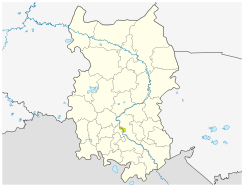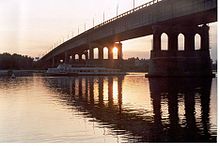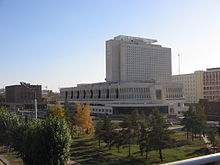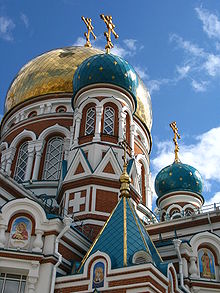- Omsk
-
For the steamships named Omsk, see SS Omsk.
Omsk (English)
Омск (Russian)- City[citation needed] -
City of oblast significance[citation needed]
View of the Ilyinsky Microdistrict of Omsk from across the Irtysh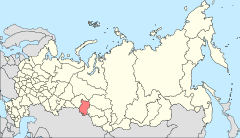
Location of Omsk Oblast in RussiaCoordinates: 54°59′N 73°22′E / 54.983°N 73.367°ECoordinates: 54°59′N 73°22′E / 54.983°N 73.367°E Coat of arms Flag City Day First Saturday of August[citation needed] Administrative status Country Russia Federal subject Omsk Oblast Administrative center of Omsk Oblast[citation needed] Municipal status Urban okrug Omsk Urban Okrug[citation needed] Administrative center of Omsk Urban Okrug[citation needed] Mayor[citation needed] Viktor Shreyder[citation needed] Representative body City Council[citation needed] Statistics Area 573 km2 (221 sq mi)[1] Population (2010 Census,
preliminary)1,153,971 inhabitants[2] - Rank in 2010 7th Population (2002 Census) 1,134,016 inhabitants[3] - Rank in 2002 7th Density 2,014 /km2 (5,220 /sq mi)[4] Time zone OMSST (UTC+07:00)[5] Founded August 2, 1716[citation needed] Postal code(s) 644xxx[citation needed] Dialing code(s) +7 3812[citation needed] Official website Omsk (Russian: Омск) is a city and the administrative center of Omsk Oblast, Russia, located in southwestern Siberia 1,389 kilometers (863 mi)[6] from Moscow. In terms of population, it is Russia's second-largest city east of the Ural Mountains, and seventh by size nationally.[2]
During the Imperial era, Omsk was the seat of the Governor General of Western Siberia, and later of the Governor General of the Steppes. For a brief period during the Russian Civil War in 1918–1920, it served as the capital of the anti-Bolshevik Russian State and held the imperial gold reserves.
Omsk is the administrative center of the Siberian Cossack Host. It also serves as the see of the bishop of Omsk and Tara, as well as the administrative seat of the Imam of Siberia.
Contents
Location
Omsk stretches along on the banks of the north-flowing Irtysh at its confluence with the smaller Om River. The city has an elevation of 87 meters (285 ft) above sea level at its highest point.
Omsk is an important railroad hub, and is the junction point for the northern and southern branches of the Trans-Siberian Railway. The city also serves as a major hub for the regional highway network. River-port facilities handle both passengers and freight, giving the city access to the extensive navigable waterways of the Irtysh and Ob rivers. The waterways connect Omsk with the coal and mineral-mining towns further up the river in Kazakhstan, as well as with the oil, natural gas and lumber operations of northern Siberia. Omsk is served by the Tsentralny Airport, which offers access to domestic and international (primarily, German and Kazakh) destinations, making the city an important aviation hub for Siberia and the Russian Far East.
Climate
The climate is dry and continental, characterized by dramatic swings of weather. The average daily temperatures, taken over the past three decades, are +20 °C (68 °F) for July and −17 °C (1 °F) for January, although temperatures can reach +45 °C (113 °F) in the summer and drop to −45 °C (−49 °F) in the winter. On average, Omsk sees over 300 sunny days in any given year. Average annual rainfall is 315 millimeters (12.4 in).
Climate data for Omsk Month Jan Feb Mar Apr May Jun Jul Aug Sep Oct Nov Dec Year Record high °C (°F) 4.2
(39.6)3.6
(38.5)14.1
(57.4)31.3
(88.3)35.5
(95.9)40.1
(104.2)40.4
(104.7)38.0
(100.4)32.9
(91.2)27.4
(81.3)16.1
(61.0)4.5
(40.1)40.4
(104.7)Average high °C (°F) −12.6
(9.3)−11.1
(12.0)−3.5
(25.7)9.0
(48.2)18.4
(65.1)24.0
(75.2)25.4
(77.7)22..2
(72)15.8
(60.4)7.3
(45.1)−4.3
(24.3)−9.6
(14.7)6.73
(44.12)Average low °C (°F) −21.2
(−6.2)−20.2
(−4.4)−13.3
(8.1)−0.9
(30.4)5.8
(42.4)11.8
(53.2)14.0
(57.2)11.2
(52.2)5.5
(41.9)−1
(30)−11.4
(11.5)−17.9
(−0.2)−3.13
(26.36)Record low °C (°F) −45.1
(−49.2)−45.5
(−49.9)−41.1
(−42.0)−25.5
(−13.9)−11.2
(11.8)−3.1
(26.4)2.1
(35.8)−1.7
(28.9)−7.6
(18.3)−28.1
(−18.6)−41.2
(−42.2)−44.7
(−48.5)−45.5
(−49.9)Precipitation mm (inches) 24
(0.94)16
(0.63)14
(0.55)21
(0.83)35
(1.38)50
(1.97)60
(2.36)56
(2.2)36
(1.42)31
(1.22)30
(1.18)27
(1.06)400
(15.75)% humidity 80 78 77 66 53 59 67 70 70 74 82 81 71.4 Sunshine hours 68.2 126.0 182.9 234.0 285.2 318.0 322.4 248.0 180.0 105.4 72.0 62.0 2,204.1 Source no. 1: [7] Source no. 2: [8] History
The wooden fort of Omsk was erected in 1716 to protect the expanding Russian frontier along the Ishim and the Irtysh rivers against the Kyrgyz nomads of the Steppes. In the late eighteenth century, stronger works of brick were erected on the right bank of the Om; of these, the original Tobolsk and the restored Tara gates still stand, along with the original German Lutheran Church, an armoury, a military jail, and commandant's house.
In the nineteenth and early twentieth century, Omsk became the administrative center of Western Siberia and the Steppes (Kazakhstan), acquiring a few churches and cathedrals of various denominations, mosques, a synagogue, the governor-general's mansion, a military academy. Because of the complexity of the bureaucratic institutions in the city, ink was joked to have been sold by the bucketful. As the frontier receded and its military importance diminished, the town fell into lethargy; it was during the mid-nineteenth century that Dostoevsky lived and wrote in exile here.
The new boom began with the construction of the Trans-Siberian Railway in 1890s, which caused merchants to flock to the city in order to take advantage of the rail/river junction. Many trade companies established stores and offices in Omsk, resulting in the construction of the picturesque old district of the city, and contributing to the rapid development of Omsk into a major city. British, Dutch and German consulates were established at about the same time in order to represent their commercial interests. The pinnacle of development for pre-revolutionary Omsk came with the lavish Siberian Exposition of Agriculture and Industry in 1910, for which a complex of buildings and fountains was constructed. In line with the popularity of World Fairs of the day, the exposition influenced observers to foretell the wonders of the "Chicago of Siberia".
Shortly after the 1917 revolution, anti-bolshevik "white" forces seized control of Omsk. The "Provisional Government of Russia" was established here in 1918, headed by the arctic explorer and decorated war hero Admiral Kolchak. Omsk was proclaimed the capital of Russia, and its central bank was tasked with safekeeping the former empire's gold reserves. The reserves were guarded by a garrison of former Czechoslovakian POWs trapped in Siberia by the chaos of The First World War and the subsequent Russian Revolution. Omsk became a prime target for the Red Army, who viewed it as crucial to their Siberian campaign, eventually forced Kolchak, his government, and the gold to abandon the city and retreat along the Trans-Siberian eastward to Irkutsk. Bolshevik forces entered the city in 1919.
Soviet era
The Soviet government preferred the young Novonikolayevsk, which is now called Novosibirsk, as the administrative center of Western Siberia, prompting the mass transfer of administrative, cultural and educational functions from Omsk, dampening the city's growth and sparking a rivalry between the two cities that continues to this day. The city received new life as a result of The Second World War - because it was both far from the fighting and had a well-developed infrastructure, Omsk was a perfect haven for much of the industry evacuated away from the front in 1941. Additionally, in contingency plans were made to transfer the provisional Soviet capital to Omsk, in the event of a German victory during the Battle of Moscow. At the end of the war Omsk remained a major industrial center, and became a leader in Soviet military production. The concentration of military enterprises also had negative effects, as until 1990, the city stayed closed to foreigners, and, after 1990, the collapse of the Soviet military demand led to high unemployment.
Military industries which moved here included part of the OKMO tank design bureau in 1941, and S.M. Kirov Factory no. 185 from Chelyabinsk, in 1962. The Kirov Factory and Omsk Transmash design bureau (KBTM) produced T-80 tanks from the 1970s, and were responsible for the BTR-T, TOS-1, and the prototype Black Eagle tank. Omsk Transmash declared bankruptcy in 2002.
In the 1950s, following the development of oil and natural gas field in Siberia, an oil-refining complex was built, along with an entire "town of oilworkers", expanding Omsk northward along the Irtysh. It is currently the largest such complex in Russia. Gazprom Neft, the parent company, is the largest employer in the city, wielding its tax address as leverage in negotiations with municipal and regional authorities.
Post Soviet Era
 Nightlife around the Mayakovsky entertainment complex
Nightlife around the Mayakovsky entertainment complex
Following the collapse of the Soviet Union, Omsk experienced a period of economic instability and political stagnation. Most of the city's large businesses, which had previously been state owned, were fought over by members of the former party elite, the emerging nouveau riche, and the fast growing criminal syndicates. The most notorious cases involved the privatisation of Sibneft, a major oil company, which dragged on for several years. Until the end of the 1990s, the political life of the city was defined by an ongoing feud between regional and the municipal authorities. The resulting conflict made at least two points of view available to the public and served as the impetus for some improvements to the city's infrastructure and cultural life, including the construction of new leisure parks and the renovation of the city's historic downtown, the establishment of the annual Siberian International Marathon, and of the annual City Days Festival. Despite this, political infighting drained the city's resources and served as a major obstacle to smooth government operation and city development. The conflict was finally resolved in favour of the regional government with the forced resignation of two consecutive mayors and the subsequent de facto appointment of their successor by the regional governor. Since the turn of the century, the regional government has been firmly in control of Omsk's government, courts and media. The city is currently an underperformer, by Russian standards, in both economic growth and quality of life.
On March 2, 2005, the Consulate General of the Republic of Kazakhstan was opened. Previously in 1943, the Free India Government in Exile had opened its consulate in Omsk. Additionally, both Germany and Slovakia maintain honorary consuls in the city.
Demographics
The population in Omsk rose from 31,000 in 1881 to 53,050 in 1900 and to 1,148,418 in 1989 Census. The 2002 Census recorded that the population declined to 1,134,016,[3] but it rebounded somewhat by the 2010 Census, which showed the population of 1,153,971.[2]
Cityscape
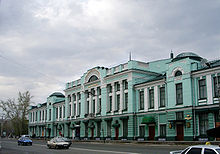 Mikhail Vrubel Museum of Fine Arts
Mikhail Vrubel Museum of Fine Arts
The architectural centerpiece of the city is an ensemble of buildings along Lyubinsky Avenue/Lenin Street, anchored by the former Gostiny Dvor, and flanked by two chapels. The area is an eclectic mix of architectural styles, dominated by Art-Nouveau, Neoclassical and Second Empire. The Drama Theatre gives a good example of the latter. Soviet Era additions run the gamut from Constructivist, to Stalinist to Brutalist.
Closer to the confluence of the Om and the Irtysh are the few surviving sombre buildings of the 18th-century fortress. The largest and most opulent church in the city is the Dormition Cathedral, a five-domed edifice in the Russian Revival style, consecrated in 1896, demolished by the Soviets, and restored in the early first decade of the 21st century.
Another area of interest is Nikolsky Prospekt/Krasnykh Zor Street, where a line of merchants' wooden houses still stands. The street leads to the Neoclassical cathedral of St Nicholas, which was commissioned by the Cossacks, designed by Vasily Stasov and consecrated in 1840. It contains various relics of the Siberian Cossacks.
Life and culture
As a prominent educational center, Omsk has a large number of museums, theaters, music venues, and educational institutions.
Among Omsk's museums, the most notable are:
- The State Museum of Regional History
- The Dostoyevsky Museum of Literature
- The Vrubel Museum of Fine Arts
- The Military Museum Complex
- The Kondraty Belov Art Museum
- The Liberov Center for Art
Theaters include the Omsk Opera, The Omsk Theater of Drama, The Omsk Circus, and a number of smaller venues.
Education
Omsk is home to many institutions of higher learning and several universities:
- ANO - Institute of Economics and Energetics
- AKSI - Aksenov Institute of Law and Economics, West Siberian department
- Law and Economics Institute
- Omsk Academy of Law
- Omsk Academy of MVD Rossija
- Omsk Aviation Technical School
- Omsk Foreign Language Institute
- Omsk Medical Academy
- Omsk State Transport University (1961)
- Omsk State Agrarian University (1918) (connected with Omsk State Veterinary Institute and Institute of Agribusiness and Continuing Education)
- Omsk State Pedagogical University
- Omsk State University (1974)
- Omsk Institute of Consumer Service Technology
- Omsk State Technical University (1942)
- SibADI - Siberian State Automobile and Highway Academy
- SibGUFK - Siberian Academy of Physical Culture
- Siberian Institute of Business and Information Technology
- Sovremennyi Gomunitarnyi University
- SIBNFOR - Siberian Stock Market Institute
Sports
Omsk is represented nationally by professional football and hockey clubs, with the later, Avangard Omsk winning the 2004 National Championship. Avangard is part of the Kontinental Hockey League.
Transport
Main article: Omsk MetroOmsk is a major rail, road and air hub. The city is served by a station on the Trans-Siberian Railroad, and by the Tsentralny Airport. Additionally, Omsk possesses a river port on the Irtysh, offering service to domestic destinations and to cities within Kazakhstan.
Municipal Transport consists of a large bus and trolley, and tram networks, although the latter of these has deteriorated severely since the collapse of the USSR. Marshrutkas (shared taxis) supplement municipal transit networks.
A subway system, proposed in the late 1980s, but postponed for lack of funds, is currently under construction, with the Metro bridge over the Irtysh river. The bridge is already opened for cars (upper level), but the metro (lower level) is still under construction. As a first step, one short line will connect the districts in the northwest with the city centre. The first line of the metro is scheduled to be finished in 2017.
Notable citizens
- Fyodor Dostoyevsky, writer and essayist, in exile 1849-1854
- Mikhail Vrubel, painter, born 1856
- Admiral Kolchak, anti-bolshevik "Supreme Ruler of Russia", headed resistance from Omsk 1918-1919
- Vikentii Trofimov, painter, Vrubel Art School painting section headmaster 1924-1932
- Mikhail Ulyanov, actor, studied at Drama Theater 1944-1946
- Yegor Letov, punk rocker 1964-2008
- Aleksei Kazannik, politician (yielded elected Supreme Soviet office to Boris Yeltsin), taught at OmSU 1980s and 90s
- German Gref, politician and economist, attended OmSU 1985-1990
- Eduard Kunz, pianist, born
- Mikhail Emelyanovich Yavorskiy, veteran of WWII, colonel, first anti-missle defence division, Honorary of Russian Writers Union 2010
- Vlada Roslyakova, model
Athletes
- Irina Tchachina, rhythmic gymnast
- Aleksei Tishchenko, boxer
- Evgeniya Kanaeva, rhythmic gymnast
- Roman Sloudnov, swimmer
- Nikita Nikitin, professional hockey player
- Svetlana Karpeeva, Olympic swimmer
- Galima Shugurova, rhythmic gymnast
- Dmitri Sychev, football player
- Irek Gimayev, hockey player
- Anastasija Reiberger, 1999 pole vault indoor world champion
- Yuri Shatalov, hockey player
- Dennis Siver, mixed martial arts fighter
- Alexander Shlemenko, mixed martial arts fighter
Twin towns/sister cities
Omsk is twinned with:
 Puchov, Slovakia
Puchov, Slovakia Karlovy Vary, Czech Republic
Karlovy Vary, Czech Republic Kaifeng, China
Kaifeng, China Jinju, South Korea
Jinju, South Korea Petropavl, Kazakhstan
Petropavl, Kazakhstan Pavlodar, Kazakhstan
Pavlodar, Kazakhstan Novosibirsk, Russia
Novosibirsk, Russia Kaliningrad, Russia
Kaliningrad, Russia Chelyabinsk, Russia
Chelyabinsk, Russia Milwaukee, United States
Milwaukee, United States Ontario, Canada
Ontario, Canada York Region, Canada
York Region, Canada
Honors
- The 3406 Omsk asteroid, which lies in the main asteroid belt, is named after the city.[9]
References
- ^ admomsk.ru
- ^ a b c Федеральная служба государственной статистики (Federal State Statistics Service) (2011). "Предварительные итоги Всероссийской переписи населения 2010 года (Preliminary results of the 2010 All-Russian Population Census)" (in Russian). Всероссийская перепись населения 2010 года (All-Russia Population Census of 2010). Federal State Statistics Service. http://www.perepis-2010.ru/results_of_the_census/results-inform.php. Retrieved 2011-04-25.
- ^ a b Федеральная служба государственной статистики (Federal State Statistics Service) (2004-05-21). "Численность населения России, субъектов Российской Федерации в составе федеральных округов, районов, городских поселений, сельских населённых пунктов – районных центров и сельских населённых пунктов с населением 3 тысячи и более человек (Population of Russia, its federal districts, federal subjects, districts, urban localities, rural localities—administrative centers, and rural localities with population of over 3,000)" (in Russian). Всероссийская перепись населения 2002 года (All-Russia Population Census of 2002). Federal State Statistics Service. http://www.perepis2002.ru/ct/doc/1_TOM_01_04.xls. Retrieved 2010-03-23.
- ^ The value of density was calculated automatically by dividing the 2010 Census population by the area specified in the infobox. Please note that this value may not be accurate as the area specified in the infobox does not necessarily correspond to the area of the entity proper or is reported for the same year as the population.
- ^ Правительство Российской Федерации. Постановление №725 от 31 августа 2011 г. «О составе территорий, образующих каждую часовую зону, и порядке исчисления времени в часовых зонах, а также о признании утратившими силу отдельных Постановлений Правительства Российской Федерации». Вступил в силу по истечении 7 дней после дня официального опубликования. Опубликован: "Российская Газета", №197, 6 сентября 2011 г. (Government of the Russian Federation. Resolution #725 of August 31, 2011 On the Composition of the Territories Included into Each Time Zone and on the Procedures of Timekeeping in the Time Zones, as Well as on Abrogation of Several Resolutions of the Government of the Russian Federation. Effective as of after 7 days following the day of the official publication).
- ^ mapcrow.info
- ^ Pogoda.ru.net. Accessed August 2011.
- ^ HKO "Climatological Information for Cita, Russia." Hong Kong Observatory. Accessed August 2011.
- ^ Dictionary of Minor Planet Names - p.284
External links
- Official website of Omsk City Administration
- http://club.eomsk.ru/
- Omsk Today, Omsk and the Omsk Oblast news in English
- RMX.ru, Open Omsk, an independent news source
- Omsktime.ru, Current events in Omsk (Russian)
- Blogspot.com, Photoblog about Omsk
- Univer.omsk.su, Omsk-On-Line
Cities and towns in Omsk Oblast Administrative center: Omsk

Historical capitals of Rus' and Russian states and their predecessors Predecessors of modern RussiaNovgorod Rus', Kievan Rus' Ryurikovo Gorodische, Novgorod (862–882) · Kiev (882–1169)Vladimir-Suzdal Vladimir-on-Klyazma (1169–1328)Grand Duchy of Moscow Vladimir-on-Klyazma (1169–1328)Tsardom of Russia Moscow (1328–1565) · Oprichnina: Tsar’s residence in Alexandrova Sloboda (1564/1565–1572/1584) · Moscow (1572–1611) · Provisional government "Council of All Land": Yaroslavl (1611–1612) · Moscow (1612–1712) · Sankt Pieter Burch/Saint Petersburg (1712–1728)Russian Empire, Russian Republic Sankt Pieter Burch/Saint Petersburg (1712–1728) · de facto Moscow (1728–1730) · Saint Petersburg/Petrograd (1730–...)Anti-Bolshevik (White movement) Soviet Union (USSR included Russia from 1922–1991, Russian Federation is the legal successor of the USSR)Soviet Union Modern Russia (since 7 November 1917)Soviet Russia, RSFSR, Russian Federation Categories:- Cities and towns in Omsk Oblast
- Omsk
- Populated places established in 1716
Wikimedia Foundation. 2010.

